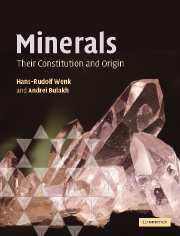Book contents
- Frontmatter
- Contents
- Preface
- Acknowledgments
- Figure credits
- Part I Structural features of minerals
- Part II Physical investigation of minerals
- Part III Variety of minerals and mineral-forming processes
- Part IV A systematic look at mineral groups
- Part V Applied mineralogy
- 30 Metalliferous mineral deposits
- 31 Gemstones
- 32 Cement minerals
- 33 Minerals and human health
- 34 Mineral composition of the solar system
- 35 Mineral composition of the earth
- Appendices
- Glossary
- References
- Index
- Plate section
- References
33 - Minerals and human health
from Part V - Applied mineralogy
- Frontmatter
- Contents
- Preface
- Acknowledgments
- Figure credits
- Part I Structural features of minerals
- Part II Physical investigation of minerals
- Part III Variety of minerals and mineral-forming processes
- Part IV A systematic look at mineral groups
- Part V Applied mineralogy
- 30 Metalliferous mineral deposits
- 31 Gemstones
- 32 Cement minerals
- 33 Minerals and human health
- 34 Mineral composition of the solar system
- 35 Mineral composition of the earth
- Appendices
- Glossary
- References
- Index
- Plate section
- References
Summary
Introduction
Mineralogy and its methods of investigation are finding increasing use in medicine and in environmental health applications. There are many examples where biologists, physicians, pharmacists, and environmental health professionals rely on the expertise provided by mineralogists. On the one hand, minerals may constitute health hazards. Exposure to asbestos, toxic waste from mining operations, or radiation due to radioactive decay may cause cancer or other diseases. On the other hand, minerals such as salt and calcium are essential nutritional components and, as we have seen in Chapter 23, both bones and teeth are composed of mineral-like crystals.
Minerals are also extensively used in beauty and grooming products. For example, talc is an important ingredient of many cosmetic products, baby powder being one of the better known ones. Minerals such as kaolinite, smectite, nontronite, biotonite, and hectorite clays are used in cosmetics, toothpaste, and pharmaceuticals, while mica provides the sheen in lipstick. Most consumers are generally unaware of most of these mineral ingredients.
In this chapter we will explore some of the aspects of minerals related to human health, in both positive and negative ways. In so doing, we will see that our overall health and well-being is intimately connected with the world of minerals.
Mineral-like materials in the human body
The principal mineral-like compounds in humans are phosphates, but other mineral-like crystals occur as well (Table 33.1). Bones of adults consist of approximately 70% calcium phosphate and 30% organic matter.
- Type
- Chapter
- Information
- MineralsTheir Constitution and Origin, pp. 558 - 569Publisher: Cambridge University PressPrint publication year: 2004



